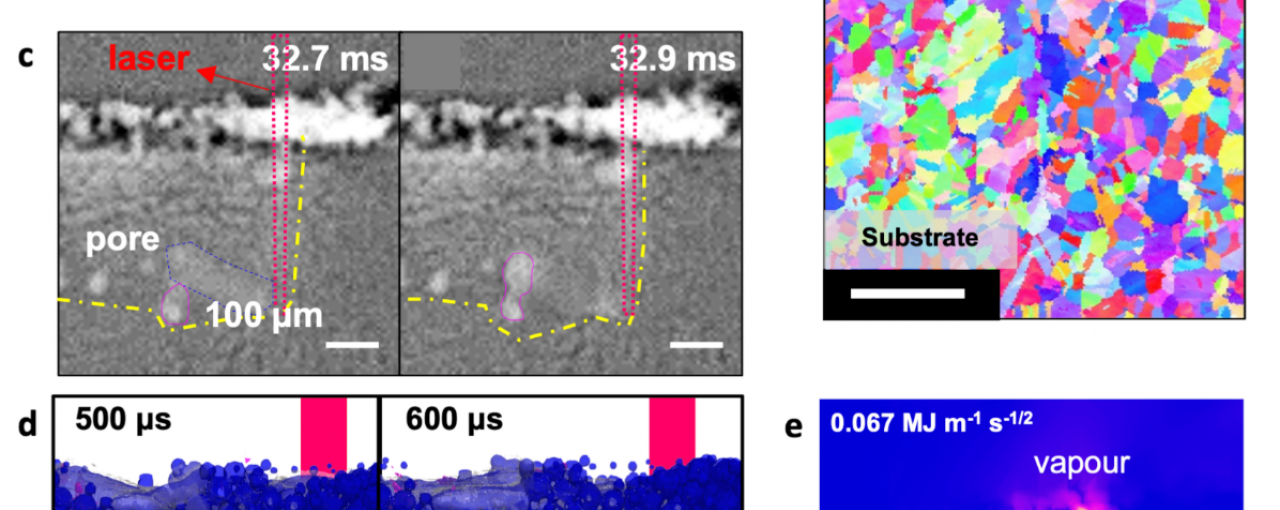Laser powder bed fusion (LPBF) is a form of additive manufacturing (AM) that transforms a 3D digital design into a net-shaped component by selectively fusing powder particles with a focused laser beam, layer upon layer. AM is widely used in many industries, including aerospace, automotive, biomedical, energy and naval sectors due to reduced material waste and improved design flexibility. However, its adoption for safety-critical applications in demanding operating environments, such as turbine blades and ship propellers, is hampered by the presence of imperfections owing to the process and product inconsistency.
Scientists at the Research Complex at Harwell, Diamond Light Source, European Space Agency, UCL, Dalian University of Technology and Rolls-Royce plc. have collaborated to evaluate the evolution of porosity and humps during LPBF using X-ray and electron imaging, and a high-fidelity multiphase process simulation. During laser powder bed fusion 3D printing, a sunken area, known as a keyhole, frequently forms, which is caused by recoil pressure created by vapours. Keyhole dynamics are very complex and difficult to predict because of its dependence upon many physical mechanisms. It is very important to be able to quantify the occurrence of keyholes’ collapse because it is highly related to defect formation in metal 3D printing.
Their research has revealed that the pore and keyhole formation mechanisms are driven by the mixing of high temperatures and high metal vapor concentrations in the keyhole. The irregular pores are formed via keyhole collapse, pore coalescence, and then pore entrapment by the solidification front. The mixing of the fast-moving vapor plume and molten pool induces a Kelvin-Helmholtz instability at the melt track surface, forming humps. Research Complex provided the laboratory space and allowed the team to prepare the initial experimental conditions and optimise our experimental setup.
Scientists combined high energy X-ray imaging at beamline I12, Diamond’s Joint Engineering and Processing experimental station, and high-fidelity modelling to quantify the pore evolution kinetics, pore size distribution, waviness, surface roughness, and melt volume under single layer conditions. High energy synchrotron X-rays are necessary to obtain high speed radiography in dense materials such as nickel-based alloys commonly used in industries such as aerospace. This work provides important insights on key criteria that govern the formation of imperfections in LPBF and paves the way for new methods to improve process reliability.
Lead author, Co-Director of the Materials, Structure and Manufacturing Group at Research Complex and Lecturer of Advanced Materials and Manufacturing at UCL, Dr Chu Lun Alex Leung said ‘
We have a fantastic international team of researchers and engineers who pull together different modalities of data to explain how imperfections are formed during metal printing. I hope this work will stimulate more exciting research in using synchrotron X-ray imaging and high-fidelity process modelling to study advanced manufacturing processes.
The authors acknowledge financial support from the EPSRC MAPP Future Manufacturing Hub (EP/P006566/1, www.mapp.ac.uk), Manufacturing by Design (EP/W003333/1) and Made Smarter Innovation – Materials Made Smarter Research Centre (EP/V061798/1); Data-driven, Reliable, and Effective Additive Manufacturing using multi-BEAM technologies (EP/W037483/1), other grants: (EP/R511638/1, EP/I02249X/1 and EP/M009688/1) and a Royal Academy Engineering Emerging Chair (CiET1819/10).
Quantification of Interdependent Dynamics during Laser Additive Manufacturing Using X-Ray Imaging Informed Multi-Physics and Multiphase Simulation. Chu Lun Alex Leung, Dawid Luczyniec, Enyu Guo, Sebastian Marussi, Robert C. Atwood, Martina Meisnar, Ben Saunders and Peter D. Lee, Advanced Science, 2203546 (2022) (Early View). DOI: https://doi.org/10.1002/advs.202203546


